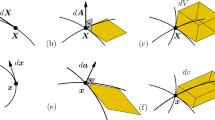Abstract
Placental abruption is the most common cause of fetal deaths in motor-vehicle crashes, but studies on the mechanical properties of human placenta are rare. This study presents a new method of developing a stochastic visco-hyperelastic material model of human placenta tissue using a combination of uniaxial tensile testing, specimen-specific finite element (FE) modeling, and stochastic optimization techniques. In our previous study, uniaxial tensile tests of 21 placenta specimens have been performed using a strain rate of 12/s. In this study, additional uniaxial tensile tests were performed using strain rates of 1/s and 0.1/s on 25 placenta specimens. Response corridors for the three loading rates were developed based on the normalized data achieved by test reconstructions of each specimen using specimen-specific FE models. Material parameters of a visco-hyperelastic model and their associated standard deviations were tuned to match both the means and standard deviations of all three response corridors using a stochastic optimization method. The results show a very good agreement between the tested and simulated response corridors, indicating that stochastic analysis can improve estimation of variability in material model parameters. The proposed method can be applied to develop stochastic material models of other biological soft tissues.






Similar content being viewed by others
References
Dar, F. H., J. R. Meakin, and R. M. Aspden. Statistical methods in finite element analysis. J. Biomech. 35:1155–1161, 2002.
Hallquist, J. O. Ls-Dyna Theoretical Manual. LSTC. 2006.
Holland, J. H. Adaptation in Natural and Artificial Systems. Ann Arbor, MI: The University of Michigan Press, 1975.
Hu, J., X. Jin, J. B. Lee, L. Zhang, V. Chaudhary, M. Guthikonda, K. H. Yang, and A. I. King. Intraoperative brain shift prediction using a 3d inhomogeneous patient-specific finite element model. J. Neurosurg. 106:164–169, 2007.
Hu, J., K. D. Klinich, C. S. Miller, G. Nazmi, M. D. Pearlman, L. W. Schneider, and J. D. Rupp. Quantifying dynamic mechanical properties of human placenta tissue using optimization techniques with specimen-specific finite-element models. J. Biomech. 42:2528–2534, 2009.
Lessley, D., J. Crandall, G. Shaw, R. Kent, and J. Funk. A Normalization Technique for Developing Corridors from Individual Subject Responses. Detroit, MI: SAE 2004 World Congress and Exhibition, 2004.
Manoogian, S. J., J. A. Bisplinghoff, C. Mcnally, A. R. Kemper, A. C. Santago, and S. M. Duma. Dynamic tensile properties of human placenta. J. Biomech. 41:3436–3440, 2008.
Manoogian, S. J., C. Mcnally, J. D. Stitzel, and S. M. Duma. Dynamic biaxial tissue properties of pregnant porcine uterine tissue. Stapp Car Crash J. 52:167–185, 2008.
Manoogian, S. J., J. A. Bisplinghoff, C. Mcnally, A. R. Kemper, A. C. Santago, and S. M. Duma. Effect of strain rate on the tensile material properties of human placenta. J. Biomech. Eng. 131:091008, 2009.
Mckay, M. D. Latin Hypercube Sampling as a Tool in Uncertainty Analysis of Computer Models. The 1992 Winter Simulation Conference, 1992.
Mckay, M. D., R. J. Beckman, and W. J. Conover. A comparison of three methods for selecting values of input variables in the analysis of output from a computer code. Technometrics 21:239–245, 1979.
Moorcroft, D. M., M. V. Jernigan, S. M. Duma, and G. G. Duma. A finite element model of the pregnant female occupant: analysis of injury mechanisms and restraint systems. Annu. Proc. Assoc. Adv. Automot. Med. 46:347–351, 2002.
Moorcroft, D. M., J. D. Stitzel, G. G. Duma, and S. M. Duma. Computational model of the pregnant occupant: predicting the risk of injury in automobile crashes. Am. J. Obstet. Gynecol. 189:540–544, 2003.
Ogden, R. W. Large deformation isotropic elasticity—on the correlation of theory and experiment for incompressible rubberlike solids. Proc. R. Soc. Lond. A. 326:565–584, 1972.
Ogden, R. W. Non-Linear Elastic Deformations. Mineola, NY: Dover Publications, INC, 1997.
Pearlman, M. D., K. D. Klinich, L. W. Schneider, J. Rupp, S. Moss, and J. Ashton-Miller. A comprehensive program to improve safety for pregnant women and fetuses in motor vehicle crashes: a preliminary report. Am. J. Obstet. Gynecol. 182:1554–1564, 2000.
Rupp, J. D., K. D. Klinich, S. Moss, J. Zhou, M. D. Pearlman, and L. W. Schneider. Development and testing of a prototype pregnant abdomen for the small-female hybrid III ATD. Stapp Car Crash J. 45:61–78, 2001.
Weiss, H. B. The epidemiology of traumatic injury-related fetal mortality in Pennsylvania, 1995–1997: the role of motor vehicle crashes. Accid. Anal. Prev. 33:449–454, 2001.
Weiss, H. B., and S. Strotmeyer. Characteristics of pregnant women in motor vehicle crashes. Inj. Prev. 8:207–210, 2002.
Yu, M., S. Manoogian, S. M. Duma, and J. D. Stitzel. Finite element modeling of human placental tissue. Ann. Adv. Automot. Med. 53:257–270, 2009.
Acknowledgments
Funds for this research were provided by the National Highway Traffic Safety Administration under Contract DTNH22-05-H-01020. The authors would like to thank Julia Samorezov for preparation of placenta specimens, Elliot Hwang for processing placenta geometric data, Rajen Kumar and Amanda Herrick for digitizing the marker data, and Brian Eby for technical support in setting up and conducting placenta tests. The authors would also like to thank Dr. Sumeet Parashar and Dr. Chang Qi for modeFRONTIER technical support.
Author information
Authors and Affiliations
Corresponding author
Additional information
Associate Editor Stefan Duma oversaw the review of this article.
Appendix
Appendix
Rights and permissions
About this article
Cite this article
Hu, J., Klinich, K.D., Miller, C.S. et al. A Stochastic Visco-hyperelastic Model of Human Placenta Tissue for Finite Element Crash Simulations. Ann Biomed Eng 39, 1074–1083 (2011). https://doi.org/10.1007/s10439-010-0222-0
Received:
Accepted:
Published:
Issue Date:
DOI: https://doi.org/10.1007/s10439-010-0222-0




